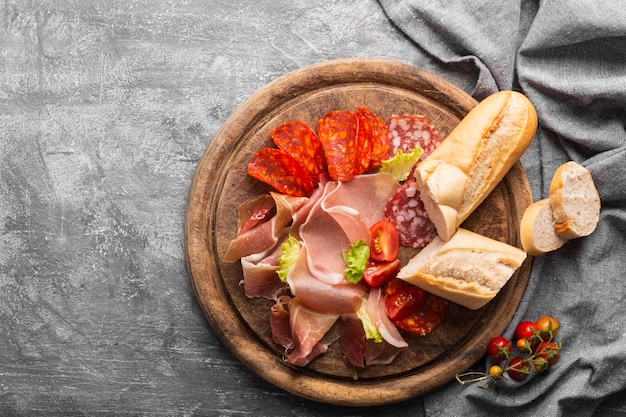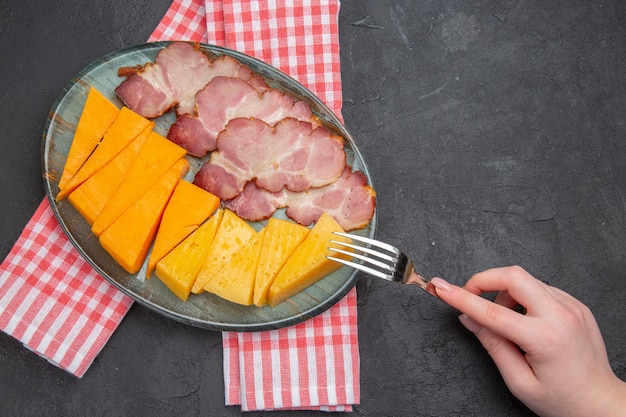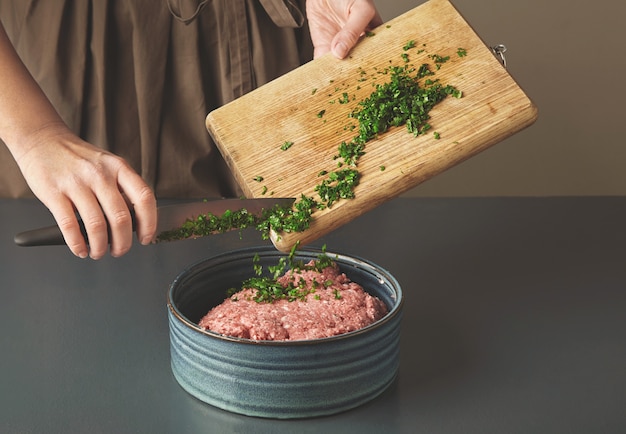Let's talk pastrami, folks. It's a culinary masterpiece, a salty, smoky, and oh-so-delicious delight that's been captivating taste buds for centuries. But good pastrami can be expensive and sometimes hard to find. Don't worry, though, because today, I'm going to reveal the secrets to crafting your own delicious pastrami at home.
I'll guide you through every step, from selecting the perfect cut of meat to mastering the curing process. We'll dive into the art of seasoning and smoking, and I'll even share some of my favourite ways to enjoy this culinary gem. So, grab your aprons, sharpen your knives, and let's embark on a flavourful journey together.
(Part 1) choosing the right cut: The Foundation of a Great Pastrami

You can't expect to build a house without a strong foundation, and the same goes for pastrami. It all starts with selecting the right cut of meat. Now, I've tried my fair share of cuts over the years, and let me tell you, not all are created equal. The best cut for pastrami is, hands down, a brisket.
Why brisket? Well, it's a tough cut with lots of marbling, which is essential for a juicy and flavorful pastrami. The marbling provides the fat needed for that melt-in-your-mouth texture that we all crave. Think of it like this: the fat renders down during the cooking process, creating a symphony of flavour and a mouthwatering experience.
Choosing a Brisket: Picking Your Perfect Cut
Now, you've got to choose the right brisket. Go for a whole brisket, either flat or point, because the bigger the cut, the more flavour it packs. I usually opt for a flat because it's easier to trim and slice, but you can go for the point if you're feeling adventurous. The point cut has more marbling, which can result in a richer flavour and a more tender final product.
Brisket Inspection: Looking for Quality
Once you have your brisket in hand, take a moment to inspect it. Look for a nice, even layer of fat and some marbling throughout. The fat should be firm, not soft or greasy. And, of course, ensure it's fresh and free of any unpleasant smells or discoloration.
(Part 2) The Curing Process: Adding Depth and Flavour

Okay, you've got your perfect brisket, and now it's time for the curing process. This is where the magic happens, where your brisket transforms into a truly remarkable pastrami.
Understanding the Cure: The Science of Flavour
Curing is essentially brining the brisket, but with a twist. Instead of just using salt, we add other ingredients, like spices and nitrates, which enhance flavour, preserve the meat, and give it that beautiful pink hue.
Let's break down the key components of a pastrami cure:
- Salt: The salt draws out moisture from the meat, creating a more concentrated flavour and helping to preserve it.
- Sugar: Sugar balances out the saltiness, adds sweetness, and enhances the browning process.
- Spices: Spices like black peppercorns, coriander seeds, paprika, and garlic powder add a complex aroma and flavour to the pastrami.
- Nitrates: Nitrates are used to prevent the growth of harmful bacteria and contribute to the characteristic pink colour of pastrami. They also react with the meat to create a unique flavour and aroma.
Some people might be wary of nitrates, but it's important to remember that they are naturally found in many foods, like spinach and celery. The amount used in a cure is small and well within safe limits.
Preparing the Cure: A Personalised Blend of Flavours
You can find pre-made pastrami cures at most butchers and online, but honestly, making your own is a rewarding experience. It allows you to control the flavour profile and experiment with different spices.
Here’s a simple cure recipe I’ve used and loved for years:
- 1 cup kosher salt
- 1/2 cup brown sugar
- 1 tablespoon black peppercorns
- 1 tablespoon coriander seeds
- 1 tablespoon paprika
- 1 teaspoon garlic powder
- 1 teaspoon onion powder
- 1 teaspoon mustard seeds
- 1/2 teaspoon red pepper flakes (optional for a kick)
- 1/2 teaspoon curing salt (pink salt)
The Curing Process: A Patient Affair
Mix all the cure ingredients together thoroughly. Now, rub the cure liberally all over your brisket, making sure every nook and cranny is covered. Place the cured brisket in a non-reactive container, such as a large Tupperware or a glass baking dish. Cover it tightly with plastic wrap and refrigerate it for 5-7 days.
During the curing process, the salt draws out moisture from the meat, while the spices infuse it with incredible flavour.
You'll want to flip the brisket over halfway through the curing period to ensure even seasoning and curing.
(Part 3) The Washing Ritual: Removing the Cure

After those days of patiently waiting, it's time to rinse away the cure. This step is crucial to remove any excess salt and ensure a balanced flavour in your finished pastrami.
Washing the Brisket: A Gentle Touch
Remove the brisket from the refrigerator and gently rinse it under cold running water. Don't be too rough, as you want to avoid damaging the surface. You want to wash off the cure, but not the spices embedded in the meat.
Patting it Dry: A Necessary Step
Once washed, pat the brisket dry with paper towels. It's essential to remove excess moisture before moving on to the next step. Moisture can interfere with the smoking process and affect the final texture of your pastrami.
(Part 4) The Smoking Ceremony: Infusing Flavour and Aroma
Now comes the fun part – smoking the brisket! This is where your pastrami will develop that irresistible smoky flavour and aroma that makes it so special.
Choosing Your Smoker: Finding the Right Tool
You can smoke your pastrami using a variety of methods, but for the best results, a smoker is ideal. You have options like a charcoal smoker, an electric smoker, or even a gas smoker. I personally prefer a charcoal smoker, but ultimately, the choice depends on your preference and budget.
Here's a quick breakdown of the pros and cons of each type of smoker:
| Smoker Type | Pros | Cons |
|---|---|---|
| Charcoal Smoker | Produces the most authentic smoky flavourProvides a lot of control over temperature and smoke | Requires more effort and attentionCan be more expensive |
| Electric Smoker | Easy to use and maintainMore consistent temperature control | Can produce a less intense smoky flavourMay not be as versatile as charcoal smokers |
| Gas Smoker | Faster heating timeMore convenient for smaller cuts of meat | Can be less flavorful than charcoal or electric smokersMay be more expensive |
Preparing Your Smoker: Setting the Stage
Before you start smoking, preheat your smoker to 225°F (107°C). Add wood chips, like hickory, apple, or pecan, to the smoker to infuse your pastrami with a beautiful smoky flavour.
Choose your wood chips based on the flavour you desire:
- Hickory: Strong, smoky flavour with a hint of sweetness.
- Apple: Fruity, sweet flavour with a gentle smoke.
- Pecan: Nutty, rich flavour with a moderate smoke.
- Mesquite: Bold, smoky flavour with a slightly bitter note.
Smoking Time: A Journey of Patience
Place the brisket on a smoker rack and smoke it for 4-6 hours, or until the internal temperature reaches 160°F (71°C). You'll want to maintain a consistent temperature throughout the smoking process.
During smoking, you'll notice a nice bark forming on the surface of the brisket. This crispy crust is one of the things that makes pastrami so unique and delicious.
To ensure even cooking, you'll want to rotate the brisket every hour or so to ensure all sides are exposed to the smoke.
(Part 5) The Resting Ritual: Allowing Flavours to Blend
After all that smoking, it's time to let your pastrami rest. This allows the flavours to meld and the meat to retain moisture.
The Importance of Resting: Patience is a Virtue
Remove the pastrami from the smoker and wrap it tightly in foil. Let it rest in a warm spot for at least 1-2 hours. The meat will continue to cook and become even more tender during this resting period.
Resting also allows the juices to redistribute throughout the meat, resulting in a more flavorful and tender final product.
Resting: Awaiting Flavour Fusion
While the pastrami is resting, you can start prepping your sides or getting ready to slice it.
(Part 6) The Art of Slicing: Unlocking the Deliciousness
The final step is slicing your pastrami. This is a crucial step, as the way you slice it can significantly impact the final texture and flavour.
Sharp Knife, Thin Slices: The Key to Pastrami Perfection
Use a very sharp knife, like a butcher knife or a chef's knife. Aim for thin, even slices, about 1/4 inch thick. The thinner the slice, the better the flavour will be, as it allows the fat to melt in your mouth.
Slicing Techniques: Experimenting with Flavour
You can experiment with different slicing techniques to create different textures. For a more rustic feel, you can slice the pastrami across the grain. For a more delicate texture, slice it with the grain.
Slicing against the grain also helps to make the pastrami easier to chew and digest.
(Part 7) Serving and Enjoying: Flavour Explosions Await
Now comes the moment of truth – the time to enjoy your homemade pastrami. There are countless ways to enjoy this culinary masterpiece.
Sandwiches: A Classic Treat
Pastrami sandwiches are a classic and for good reason. The juicy, flavorful meat pairs perfectly with rye bread, mustard, and a slice of Swiss cheese.
Here are some tips for making the perfect pastrami sandwich:
- Toast the rye bread for a crispy texture.
- Use a good quality mustard, like stone-ground or Dijon.
- Don't be afraid to pile on the pastrami.
- Add some thinly sliced pickles for a tangy contrast.
Salads: Adding Depth and Texture
Add a touch of smoky flavour and texture to your salads with slices of pastrami. It's a great way to incorporate some protein and a unique taste into your salads.
Here are some salad ideas featuring pastrami:
- Pastrami and potato salad: Combine pastrami with potato salad, Dijon mustard, and fresh parsley for a hearty and flavorful salad.
- Pastrami and Kale Salad: Toss shredded kale with pastrami, shaved Parmesan cheese, and a lemon vinaigrette for a light and refreshing salad.
- Pastrami and Brussels Sprout Salad: roast brussels sprouts with olive oil, salt, and pepper. Then, toss them with slices of pastrami, toasted pecans, and a balsamic vinaigrette for a unique and satisfying salad.
Pastrami Hash: A Hearty and Delicious Meal
Dice up some pastrami and combine it with potatoes, onions, and other vegetables for a hearty and satisfying hash.
Here's a simple pastrami hash recipe:
- 1 tablespoon olive oil
- 1 onion, chopped
- 2 cloves garlic, minced
- 1 pound potatoes, diced
- 1/2 cup pastrami, diced
- 1/4 cup chopped fresh parsley
- Salt and pepper to taste
Heat the olive oil in a large skillet over medium heat. Add the onion and garlic and cook until softened. Add the potatoes and cook until golden brown. Stir in the pastrami, parsley, salt, and pepper. Cook until heated through. Serve with a side of sour cream or yogurt.
Pastrami Pizza: A Fusion of Flavors
If you're feeling adventurous, try topping your pizza with pastrami. The salty and smoky flavours of pastrami pair beautifully with a tangy tomato sauce and mozzarella cheese.
Here's a pastrami pizza recipe to try:
- 1 pizza dough
- 1 cup tomato sauce
- 1 cup mozzarella cheese, shredded
- 1/2 cup pastrami, sliced
- 1/4 cup red onion, thinly sliced
- 1/4 cup sauerkraut
- 1 tablespoon olive oil
Preheat oven to 450°F (232°C). Spread the tomato sauce over the pizza dough. Top with the mozzarella cheese, pastrami, red onion, and sauerkraut. Drizzle with olive oil. Bake for 15-20 minutes, or until the crust is golden brown and the cheese is melted and bubbly.
(Part 8) Tips and Tricks: Mastering the Craft
Here are some tips and tricks to elevate your pastrami game:
Storing Pastrami: Keeping It Fresh and Flavorful
Store leftover pastrami in an airtight container in the refrigerator for up to 5 days. You can also freeze it for up to 3 months. When freezing, wrap it tightly in plastic wrap and then in aluminum foil to prevent freezer burn.
Adding More Flavour: Experimenting with Spices
Don't be afraid to experiment with different spices in your cure. You can add other spices like cumin, allspice, or fennel seeds to create a unique flavour profile.
Here are some flavour combinations you might enjoy:
- Spicy Pastrami: Add cayenne pepper, chipotle powder, or smoked paprika for a kick.
- Mediterranean Pastrami: Combine coriander seeds, cumin, oregano, and garlic powder for an earthy, Mediterranean flavour.
- Sweet and Smoky Pastrami: Add brown sugar, smoked paprika, and a touch of maple syrup for a sweet and smoky flavour profile.
The Importance of Time: Patience is Key
The curing and smoking process takes time. But trust me, the wait is worth it. The longer you cure and smoke the brisket, the more flavorful and tender the pastrami will be.
The Magic of Sous Vide: A Modern Twist
If you're looking for a more consistent and hands-off way to cook pastrami, try using a sous vide cooker. sous vide cooking helps to ensure even cooking and a tender, juicy pastrami.
Here's how to cook pastrami using a sous vide cooker:
- Cure the brisket as usual.
- After washing the brisket, vacuum seal it in a food-safe bag.
- Fill a large pot with water and set the temperature to 150°F (65°C).
- Submerge the sealed brisket in the water bath for 6-8 hours, or until the internal temperature reaches 150°F (65°C).
- Remove the brisket from the water bath and pat it dry.
- Smoke the brisket for 2-3 hours at 225°F (107°C) to develop a smoky flavour and bark.
- Let the brisket rest for at least 1 hour before slicing and serving.
Not Just for Sandwiches: Expanding Pastrami Horizons
Don't be limited to just sandwiches. Get creative and try pastrami in different dishes, like salads, soups, or even pasta dishes.
Here are some unique ideas to explore:
- Pastrami and bean soup: Add diced pastrami to a hearty bean soup for a smoky and satisfying meal.
- Pastrami and Pasta Salad: Combine cooked pasta with diced pastrami, cherry tomatoes, red onion, and a vinaigrette for a flavourful and easy pasta salad.
- Pastrami and potato pancakes: Add diced pastrami to your potato pancake recipe for a unique twist on a classic dish.
FAQs
What if I don’t have a smoker?
You can still make delicious pastrami without a smoker. You can roast it in the oven at a low temperature, around 250°F (121°C), for several hours. To achieve a smoky flavor, you can add a few drops of liquid smoke to the roasting pan.
How can I tell if my pastrami is cooked?
The best way to tell if your pastrami is cooked through is to use a meat thermometer. It should reach an internal temperature of 160°F (71°C). You can also check for doneness by pressing on the meat. If it’s firm to the touch, it’s cooked through.
What are some good sides to serve with pastrami?
Pastrami pairs well with a variety of sides, including potato salad, coleslaw, pickles, and sauerkraut. You can also serve it with a side of grilled vegetables or a fresh salad.
How can I prevent my pastrami from drying out?
To prevent your pastrami from drying out, keep the smoker temperature low and consistent. You can also add a small amount of water to the smoker pan to create humidity.
If you are roasting the pastrami in the oven, you can place a small roasting pan filled with water on the bottom rack to create moisture.
Can I use a different cut of meat for pastrami?
You can technically use other cuts of meat, such as a chuck roast or a shoulder roast, but they won’t have the same flavour and texture as brisket. Brisket is the best choice for making authentic pastrami.
There you have it, folks. My guide to crafting delectable pastrami at home. Remember, practice makes perfect, and each batch will bring you closer to mastering this culinary art. So, gather your ingredients, put on your apron, and get ready to create some serious flavour!
Everyone is watching

Prime Rib Roast Cooking Time Chart: Per Pound Guide
Cooking TipsPrime rib roast. Just the name conjures images of lavish dinners, crackling fires, and hearty laughter. It’s ...

How Long to Bake Potatoes in the Oven (Perfect Every Time)
Cooking TipsBaked potatoes are a staple in my kitchen. They're incredibly versatile, delicious, and surprisingly easy to m...

Perfect Rice Every Time: The Ultimate Guide to Cooking Rice
Cooking TipsAs a self-proclaimed foodie, I've always been a bit obsessed with rice. It's the foundation of countless cuisi...

The Ultimate Guide to Cooking Asparagus: Tips, Techniques, and Recipes
Cooking TipsAsparagus. The mere mention of this spring delicacy conjures up images of vibrant green spears, crisp and burs...

Ultimate Guide to Cooking the Perfect Thanksgiving Turkey
Cooking TipsThanksgiving. Just the word conjures up images of overflowing tables laden with delicious food, the scent of r...
